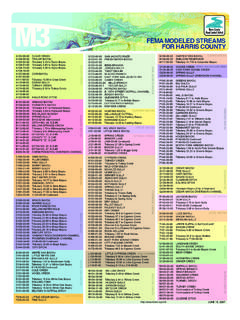Transcription of BASE FLOOD ELEVATION DETERMINATION MODULE
1 base FLOOD ELEVATIONDETERMINATION MODULEFEDERAL EMERGENCY MANAGEMENT AGENCYPREPARED BY:NOLTE ASSOCIATES, , 2003 ABSTRACTThe fema base FLOOD ELEVATION DETERMINATION MODULE is a Visual Basic applicationthat uses ArcObjects. The application automates the process of determining the baseflood ELEVATION (BFE) and FLOOD status of properties within communities. Currently, thisprocess is conducted manually by use of hard copy FLOOD Insurance Rate Maps (FIRM).Developed in conjunction with fema 's current Map Modernization efforts, thisapplication is envisioned as a viewer that will be distributed by fema at no cost tocommunities, allowing a rapid and more accurate means of determining the BFEs forstructures within the Special FLOOD Hazard Areas (SFHA) of the Federal Emergency Management Agency ( fema ) is entrusted by the Federalgovernment to administer the National FLOOD Insurance Program (NFIP).
2 This programprovides federally backed FLOOD insurance to the residents of qualifying communitiesthroughout the nation. The most highly visible icon of the NFIP is the FLOOD InsuranceRate Map (FIRM). These maps identify FLOOD prone areas within a community. Themaps are typically used by the banking and insurance industry to determine the need forthe purchase of FLOOD insurance in the Special FLOOD Hazard Areas (SFHA) ofcommunities that are in the NFIP. The communities also use the FIRMs for identifyingwhether structures are in or out of the SFHA, and for ELEVATION requirements andcompliance with local building codes. ELEVATION requirements are usually a case of astructure's ELEVATION in reference to the base FLOOD ELEVATION (BFE) as determined fromthe 1997 the Federal Emergency Management Agency ( fema ) began an ambitiousprogram called "Map Modernization".
3 Its goals were simple. Conversion of the FIRMs to a digital format Application of emerging technologies Increased involvement of State and Community partners Increased Customer Service Promote an increased awareness of FLOOD risksConversion of the FIRMs to a digital format is well underway and is progressingsmoothly. One area that is only recently being addressed, due to the emergence of GIStechnology, is that of a quick and accurate method for determining the BFE for anidentified structure within the SFHA. If a method can be economically constructed forour partners that already have or are entering into using this new arena of GIStechnology, then it would help to increase the involvement of our community partnersand lead to an increased level of customer service.
4 The positive spin off would be anincreased awareness of FLOOD PROBLEMFrom 1968 to about the early 90's, fema has collected and presented its data usingconventional analog technology. With the advent of digital data gathering technology inthe early 90's, fema has collected data in a digital fashion but has displayed orpresented its product in an analog fashion, paper maps. Since fema now has alibrary of digital data coupled with a uniform set of digital specifications, we now havethe basics for using the new digital gathering technologies such as LIDAR and GIS forthe display and queries of our information. fema 's digital specifications for DigitalFlood Insurance Rate Maps (DFIRMs) can be found an effort to close the last three feet, the distance between the community sfloodplain manager and the public, fema -Region IX wanted to create a tool for thecommunities that would use off-the-shelf digital FIS data and would enable thecommunities to have an on-demand system for displays and queries such as.
5 The base FLOOD ELEVATION (BFE) within a Special FLOOD Hazard Area (SFHA) The base FLOOD ELEVATION of a structure within an SFHA The location of a structure relative to the boundaries of the SFHA The location of a structure relative to a floodway The relative contour elevations of a site in relationship to the location of apotential goals for this new tool: Use only existing data that is normally collected during a FLOOD Insurance Study(FIS). This would enable any community with a FIS that adheres to our latestspecifications to use the product. Minimal amount of data manipulation to convert it into a usable form for its use.
6 Make it fit the regular operating scheme of how a community currentlyprocesses any queries. This was a very important consideration. If acommunity uses their parcel base as starting point for all of their work, then ourmodel should use that as its link to the SFHA and thus the BFE DETERMINATION . Make it generic so that a community could use it as a base and add in otherdatabases and layers and necessary. Don't make it an exclusive BFEdetermination tool! User friendly and simple in have chosen to call this tool the base FLOOD ELEVATION DETERMINATION MODULE (BFEDM) and will describe our SOLUTIONThe base FLOOD ELEVATION DETERMINATION MODULE is a Visual Basic program that wascreated to assist in the DETERMINATION of the base FLOOD ELEVATION as it relates to adelineated FLOOD plain.
7 More specifically, the program allows one to locate a specific siteusing an assessor parcel number. The BFEDM viewer can zoom and pan to the specifiedparcel and allow an interactive query using the cursor to determine the base FloodElevation (BFE) of a FLOOD plain that traverses the area. The program is intended toprovide a more precise means of determining the BFE using digital information andthereby eliminate the interpolation that was necessary with the paper with any mapping endeavor, the accuracy of the reported information is only asaccurate as the information used to assemble the map data. A goal in creating thisapplication was to determine the calculated BFE to within foot.
8 The program caneasily report the BFE with this degree of precision and beyond, but it is entirelydependent upon the accuracy of the delineated FLOOD plain, the accuracy of thecommunity base map and the methods used to create the virtual FLOOD plain surface thatthe program uses to calculate the surface paper presents the methodology used to assemble data that can be used by theBFEDM and report base FLOOD ELEVATION Data as well as FLOOD plain boundary, parcellocation and building development of the BFEDM was conducted as part of a FLOOD Insurance Study (FIS).The FIS provides updated FLOOD plain delineation and base FLOOD Elevations (BFE) for acommunity that is in the plains are not flat.
9 As they traverse a community, they wind and twist throughtheir confines as they flow from a higher ELEVATION to a lower ELEVATION . In moderatelyhilly terrain, a FLOOD plain exhibits a high degree of slope in contrast to flatter terrain asfound in the central valleys of California or throughout much of the Midwest. No matterwhere they exist, FLOOD plains vary continuously in ELEVATION . In order to determineelevation anywhere along the surface of the FLOOD plain, a method was needed to modelthe actual surface of a predicted FLOOD plain and then calculate on-the-fly the surfaceelevation at any point along the FLOOD plain s ability to calculate the ELEVATION of the FLOOD plain surface at any point was addressedby creating a virtual surface of the FLOOD plain.
10 The virtual surface mimicks the actualsurface characteristics of the FLOOD plain and provides a means to calculate the surfaceelevation using tools within the ArcMap or BFEDM program. Delineated FLOOD Plain BoundaryThe construction of the virtual surface model of the FLOOD plain was accomplished by firstobtaining the newly derived FLOOD plain boundary as shown above. In the case of thisparticular re-study project, the boundary was a simple polygon boundary that did notpossess ELEVATION information. FLOOD Plain Boundary Draped over Topographic DataIn order to create a FLOOD plain boundary that exhibited the three dimensional character ofthe limits of a FLOOD plain, it was necessary to drape the FLOOD plain boundary over theactual topography of the community that it was flowing through and transfer the groundelevation to the FLOOD plain boundary.





